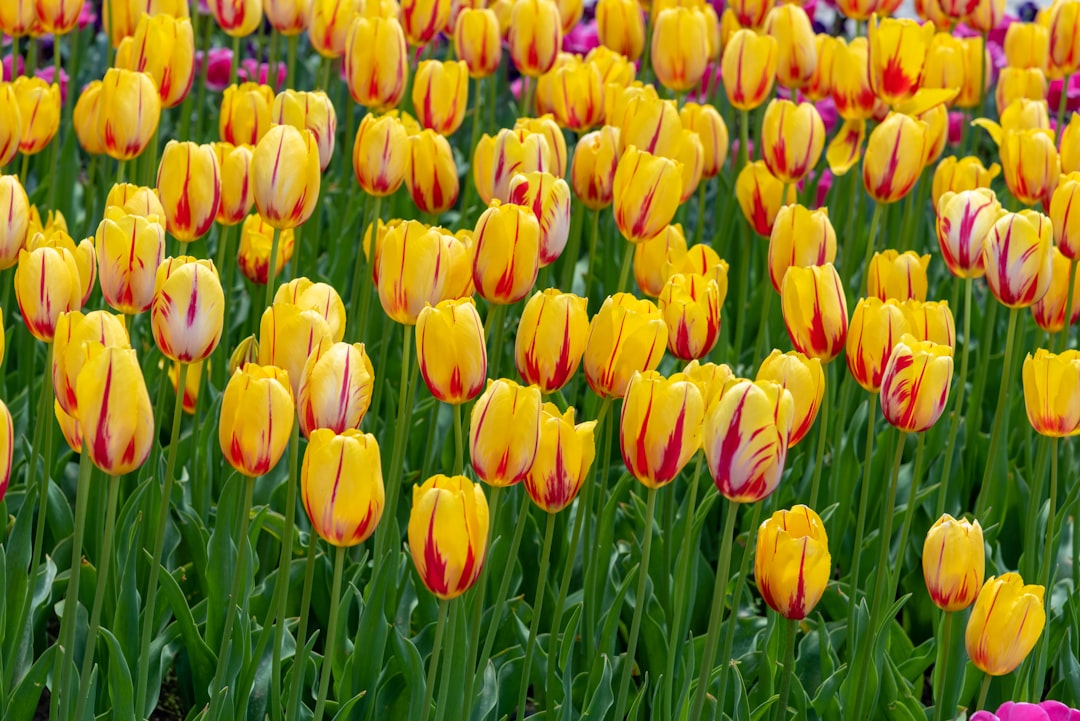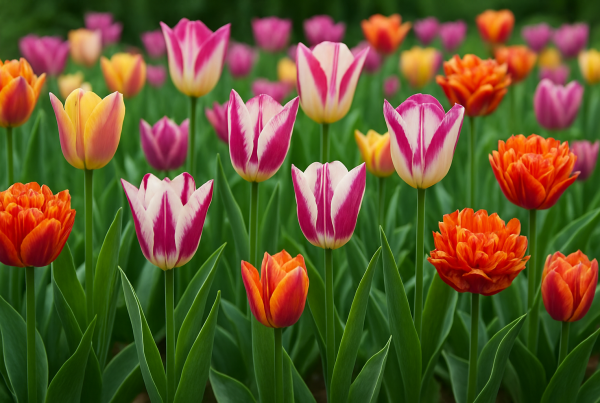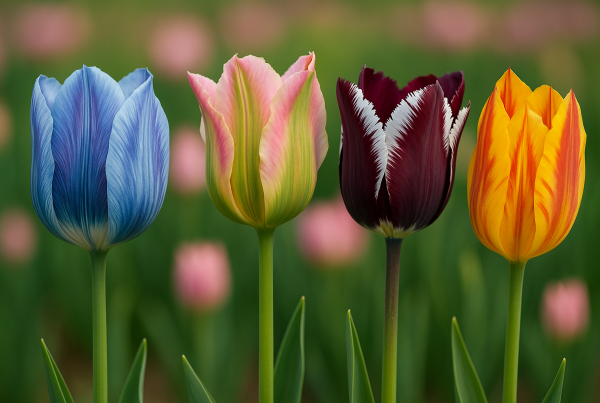Discovering Tulip Varieties: A Guide to Enchanting Species for Every Gardener
Tulips, with their vibrant colors and elegant forms, have long enchanted gardeners and flower enthusiasts worldwide. As we delve into the captivating world of tulip varieties, we invite you to explore the rich tapestry of species that can transform any garden into a burst of color and life. From the storied history of tulips in Europe to the diverse range of species found across the globe, each tulip tells a unique story. Whether you’re a seasoned gardener or a budding horticulturist, this guide will provide you with insights into the different tulip species, their scientific names, and the best practices for cultivating these stunning blooms. Join us in discovering the enchanting possibilities that tulips offer for every garden setting.
The History of Tulips
From Wildflower to Cultivated Beauty
The history of tulips is a fascinating journey from wildflower to cultivated beauty. Originally found in the mountainous regions of Central Asia, tulips were first cultivated by the Turks as early as the 10th century. By the 16th century, tulips had made their way to Europe, where they quickly became a symbol of wealth and prestige. The “Tulip Mania” of the Dutch Golden Age epitomizes this period, with tulip bulbs reaching extraordinary prices. Today, tulips are cherished worldwide, with the Netherlands still being the leading producer. Each tulip species, with its unique tulip scientific name and family, adds to the rich history of this beloved flower. Whether wild or cultivated, tulips continue to captivate gardeners, symbolizing beauty and elegance in every bloom.
History of Tulips in Europe
The history of tulips in Europe began in the late 16th century when the exotic flowers were first introduced from the Ottoman Empire. They quickly captured the fascination of botanists and the elite. The Dutch, in particular, became enamored with tulips, leading to the phenomenon known as “Tulip Mania” in the early 17th century. During this period, tulip bulbs were traded at extraordinarily high prices, sometimes exceeding the cost of a house. This speculative bubble eventually burst, but the Dutch continued to cultivate tulips, refining their techniques and developing new varieties. Today, the Netherlands remains synonymous with tulips, exporting millions of bulbs annually. The rich tapestry of tulip species found in Europe showcases the continent’s long-standing love affair with these vibrant blooms, each with its unique tulip scientific name and family.
Where Are Tulips Found in the World
Tulips are found in various regions across the globe, each contributing to the diversity of tulip species we admire today. Originally, tulips grew wild in the mountainous areas of Central Asia, including countries like Kazakhstan, Kyrgyzstan, and Uzbekistan. From there, they spread to Turkey, where they were first cultivated. With the expansion of trade routes, tulips eventually reached Europe, particularly the Netherlands, which became a major hub for tulip cultivation. Today, tulips are grown in numerous countries, including the United States, Canada, and several European nations. Each region has developed its unique varieties, adapted to their specific climates and soil conditions. Whether found in a Turkish meadow, a Dutch flower field, or a North American garden, tulips continue to enchant flower lovers worldwide, each variety bearing its distinct tulip scientific name and family.
Popular Tulip Varieties
Common and Rare Tulip Species
When exploring tulip species, you’ll find a fascinating array of both common and rare varieties. Among the most popular are the Darwin Hybrid tulips, known for their large, brightly colored blooms and strong stems, making them a favorite for garden displays and cut flowers. Another common type is the Triumph tulip, which offers a wide range of colors and is particularly valued for its uniform shape.
On the rarer side, the Parrot tulip stands out with its fringed, feather-like petals and dramatic color patterns. Another unique variety is the Rembrandt tulip, which features striking, painterly streaks on its petals, reminiscent of Dutch Golden Age artwork. Each tulip species comes with its own tulip scientific name, contributing to the rich diversity of the tulip family. Whether common or rare, these tulips offer endless possibilities for gardeners seeking to add a touch of elegance and beauty to their landscapes.
Unique Tulip Scientific Names
Tulip species are as diverse in name as they are in appearance, each with a unique tulip scientific name that reflects its distinct characteristics. The genus Tulipa belongs to the family Liliaceae, which encompasses a wide range of species. For instance, Tulipa gesneriana is one of the most iconic tulip species, often referred to as the “Garden Tulip,” and is a staple in many spring gardens. Another intriguing species is Tulipa clusiana, commonly known as the “Lady Tulip,” recognizable by its slender, star-shaped flowers.
Rare varieties like Tulipa agenensis, also known as the “Sharon Tulip,” are prized for their striking red and black blooms. Each scientific name not only identifies the species but also hints at its geographical origins or distinctive traits. Understanding these names enriches our appreciation of the tulip family, highlighting the botanical diversity and the intricate world of these beloved flowers.
Tulip Scientific Name and Family
The scientific classification of tulips places them within the genus Tulipa, part of the Liliaceae family. This family encompasses a variety of flowering plants known for their vibrant blooms and diverse forms. The tulip’s scientific name helps distinguish between its numerous species and hybrids. For instance, Tulipa gesneriana is widely recognized as the “Garden Tulip,” a popular choice for ornamental planting due to its large and colorful flowers.
The scientific nomenclature is crucial for botanists and gardeners alike, as it provides a universal language to identify and categorize the numerous tulip species found across the globe. Each tulip species has unique growth habits, flowering times, and color variations, all encapsulated in its scientific name. Understanding the tulip scientific name and family enhances our knowledge of these fascinating plants, allowing gardeners to select the right varieties for their specific climate and garden design, ensuring a stunning display each spring.
Planting and Caring for Tulips
Planting Tips for Every Season
Successfully planting tulips requires attention to timing and location, which varies by season. In autumn, plant tulip bulbs when the soil temperature is cooler, typically between 40 and 50 degrees Fahrenheit. This helps the bulbs establish roots before winter. Choose a well-drained spot with ample sunlight to ensure healthy growth.
For spring planting, select pre-cooled bulbs or those labeled as “early flowering” to catch up with the growing season. Ensure the soil is enriched with organic matter to provide nutrients as the bulbs awaken.
In summer, focus on preparing the soil for the next planting season. Remove any faded blooms and allow the foliage to die back naturally, as this replenishes nutrients in the bulbs. Consider mulching to regulate soil temperature and retain moisture.
By following these tips, you can enjoy a vibrant display of tulips year after year, adapting your planting strategy to suit your garden’s needs in every season.
Seasonal Care and Maintenance
Caring for tulips throughout the year involves specific tasks tailored to each season. In spring, as tulips begin to bloom, ensure they have adequate water, especially during dry spells. Deadhead spent flowers to direct energy back to the bulb, helping it store nutrients for next year’s growth.
During the summer, allow the foliage to die back completely before removing it. This natural process is crucial for bulb rejuvenation. Consider lifting and storing bulbs in dry climates to protect them from excessive heat and moisture. Store them in a cool, dry place until fall.
In the autumn, prepare the soil for planting by adding compost to improve drainage and nutrient content. Plant new bulbs or replant stored ones at the proper depth, typically three times the bulb’s height.
Winter care involves ensuring tulips are protected from extreme cold. Apply a layer of mulch to insulate the soil and prevent frost damage. This seasonal care routine ensures vibrant tulip displays year after year.
Troubleshooting Common Growing Issues
Growing tulips can sometimes present challenges, but understanding common issues can help you ensure healthy blooms. One frequent problem is poor drainage, which can lead to bulb rot. To prevent this, plant tulips in well-draining soil and consider using raised beds if your garden soil is heavy clay.
Another issue is pests, such as aphids and slugs, which can damage the foliage and flowers. Use organic insecticidal soap or introduce natural predators like ladybugs to control aphid populations. For slugs, consider barriers or natural deterrents like crushed eggshells.
Tulips can also suffer from fungal diseases like Botrytis blight, which causes gray mold on leaves. Ensure proper spacing and airflow between plants, and remove any affected parts promptly to prevent spread.
If blooms are sparse, it may be due to insufficient sunlight or overcrowding. Ensure tulips receive at least six hours of direct sunlight and divide overcrowded clumps to promote healthier growth.
By addressing these issues, you can maintain a thriving tulip garden.

















